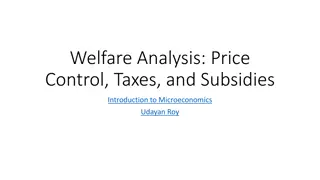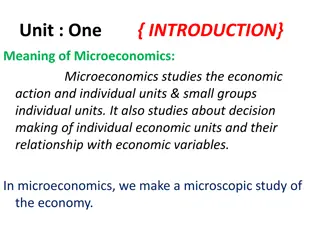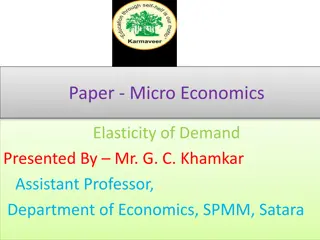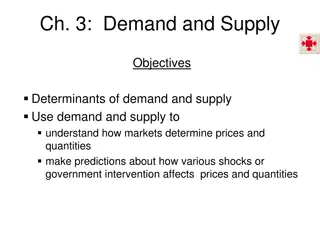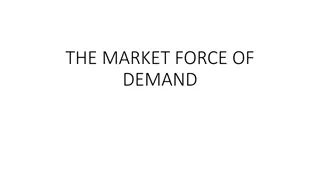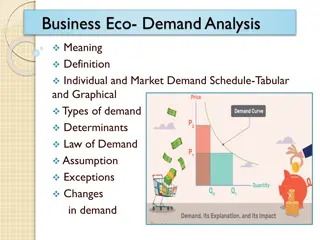Understanding Demand in Microeconomics: Principles, Determinants, and Laws
Demand analysis in microeconomics involves studying the desire backed by purchasing power for specific commodities. It is influenced by various determinants such as price, income, consumer preferences, and expectations. The Law of Demand states that as the price of a commodity falls, the quantity demanded rises, while exceptions to this law exist, such as for inferior goods and price expectations. Exploring these concepts helps in understanding consumer behavior and market dynamics.
Download Presentation

Please find below an Image/Link to download the presentation.
The content on the website is provided AS IS for your information and personal use only. It may not be sold, licensed, or shared on other websites without obtaining consent from the author. Download presentation by click this link. If you encounter any issues during the download, it is possible that the publisher has removed the file from their server.
E N D
Presentation Transcript
KHATRA ADIBASI MAHAVIDYALAYA E E- -Content Content Department : Commerce Session: 2019-2020 Semester- 6 (Programme) Subject :Principles of Micro Eco. Subject :Principles of Micro Eco. ( BCOMP601DSE Topic: Demand Analysis Topic: Demand Analysis Name of Teacher : Prof. Kalyan Name of Teacher : Prof. Kalyan Kanti ( BCOMP601DSE- -1B 1B ) ) Kanti Dutta Dutta
Definition of Demand Definition of Demand Demand is the desire backed buy purchasing power. Demand is the desire backed buy purchasing power. Demand is measured with respect to time. Demand means Demand is measured with respect to time. Demand means demand for a commodity and the commodity is to be demand for a commodity and the commodity is to be specified. Demand is measured for a particular place. Amount specified. Demand is measured for a particular place. Amount of individual or market demand maybe different at different of individual or market demand maybe different at different prices. Demand may also change due to changes in income of prices. Demand may also change due to changes in income of the consumer. the consumer.
Determinants of Demand Determinants of Demand 1 own price of product 1 own price of product 2 prices of related goods 2 prices of related goods 3 consumers income 3 consumers income 4 consumer s taste and preferences 4 consumer s taste and preferences 5 expectations regarding changes in price in future 5 expectations regarding changes in price in future 6 demonstration effect 6 demonstration effect 7 number of buyers 7 number of buyers 8 populations 8 populations 9 distribution of income 9 distribution of income 10 advertisement expenditure 10 advertisement expenditure 11 introduction of new products 11 introduction of new products 12 credit facilities and rate of interest 12 credit facilities and rate of interest
LAW OF DEMAND The The law of of any any commodity commodity falls law of of demand demand states states that falls its its quantity quantity demanded that other other things demanded rises things remaining remaining unchanged, rises and and vice unchanged, if if the vice versa versa the price price
Exceptions to the law of demand Exceptions to the law of demand 1 if the commodity is a strongly inferior goods, then the negative pause income 1 if the commodity is a strongly inferior goods, then the negative pause income effect of a fall in price is stronger than the substitution effect. effect of a fall in price is stronger than the substitution effect. 2 when the price of a commodity raises the individual may expect the price to 2 when the price of a commodity raises the individual may expect the price to rise further in future. So he will purchase more even if praise rises. rise further in future. So he will purchase more even if praise rises. 3 sometimes the customers judge the quality of any commodity by its price. So 3 sometimes the customers judge the quality of any commodity by its price. So when the price of a commodity raises, the individual may think that the quality of when the price of a commodity raises, the individual may think that the quality of the product has improved and he may purchase more of it when is price rises. the product has improved and he may purchase more of it when is price rises. This effect is known as the Veblen effect. This effect is known as the Veblen effect. 4 it is generally found in the Share market that as the price of any share falls , 4 it is generally found in the Share market that as the price of any share falls , its demand also falls . its demand also falls .
Classifications of elasticity of demand Classifications of elasticity of demand 1 income elasticity of demand 1 income elasticity of demand 2 own price elasticity of demand 2 own price elasticity of demand 3 cross price elasticity of demand 3 cross price elasticity of demand
Factos Factos determining price elasticity of demand determining price elasticity of demand 1 nature of commodity 1 nature of commodity 2 durability of the product 2 durability of the product 3 alternative uses of the commodity 3 alternative uses of the commodity 4 possibility of suspension of consumption 4 possibility of suspension of consumption 5 number and closeness of substitutions 5 number and closeness of substitutions 6 price of the commodity 6 price of the commodity 7 Buyer s income 7 Buyer s income 8 advertisement expenditure 8 advertisement expenditure 9 absolute amount of changes in price 9 absolute amount of changes in price





